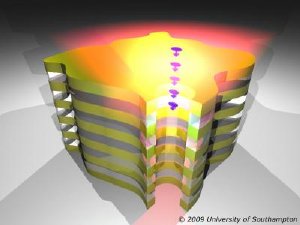Sep 21 2009
Photonics, the science of using photons to carry information, promises to continue improving a wide variety of technologies, from computing to high-speed communication. Now an international team of researchers from the UK, Taiwan, and Spain have discovered a compact way to produce infrared light, by firing electrons through a miniscule tunnel in a stack of gold and silica layers. The tiny, tunable light source could be the predecessor of a new component for light-based chips. The device is outlined in Physical Review Letters and highlighted with a Synopsis in the September 21, 2009 issue of Physics.
 A novel design for a tunable source of infrared light relies on electrons fired into a tiny hole drilled through a stack of alternating gold and silica layers. Credit: Credit: G. Adamo, Optoelectronics Research Centre, University of Southampton
A novel design for a tunable source of infrared light relies on electrons fired into a tiny hole drilled through a stack of alternating gold and silica layers. Credit: Credit: G. Adamo, Optoelectronics Research Centre, University of Southampton
A Toolbox for String Theorists
A new toolkit of equations will help theorists determine whether a promising agreement between particle physics and string theory is fact or fancy. The research is reported in Physical Review Letters and accompanied by a Viewpoint in the September 21, 2009 issue of Physics.
Physicists long for a single theory to describe the universe, but so far can't shoehorn Einstein's gravity and quantum mechanics into one elegant mathematical box. In 1997, a physicist named Juan Maldacena raised hopes of unification by proposing that the four-dimensional kingdom of a specific quantum theory was merely the border of a five-dimensional spacetime ruled by string theory. The possible harmony tantalized string theorists, but eluded proof, because the two theories were almost impossible to compare.
Now Nikolay Gromov, Vladimir Kazakov, and Pedro Vieira have assembled a hefty toolbox of equations to help the thwarted string theorists tackle the question. With these tools in hand, theorists can measure the predictions of string theory against a slew of the quantum theory's results with unprecedented ease, placing them closer to finding out if Maldacena's idea is rock solid or the stuff of dreams.
Also in Physics this week:
Thierry Giamarchi writes a Viewpoint on a Physical Review Letters paper probing the cocktail of standard and exotic physics that governs the electrons in a ladder-like arrangement of molecules in a metal.